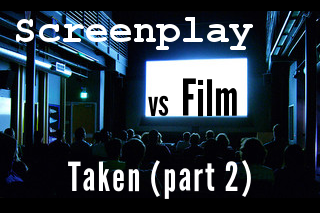Today’s post is the second half of last week’s, 8 Screenwriting Tips from Taken. In the spirit of transparency, I originally published these tips in one long post. But a wise friend told me it was way too long and I should split it in half. So here you are.
Even though there weren’t many differences between Taken’s screenplay and the movie released in theaters, it was a great action-thriller to study. If you have other action/thriller movies you’d like to see analyzed in this Screenplay vs Film series, please say so in the comments!
Now onto the rest of the screenwriting tips:
Screenwriting Tip #4: Revealing personality through names
You probably already know the importance of names. Names reflect the essence of an object, so the names of your characters should reflect their essence as well. How to choose a name for your characters is a topic unto itself. I remember that Elizabeth George’s Write Away had lots of good advice in it, and also described her approach to choosing names.
But this tip is about changing names, not choosing them. Changing the name of your character is a simple and easy way to show that your character has changed from the person they used to be.
You probably know someone from college who did the same thing. Senior year, you shared a house with a young buck who went by the moniker of Bobby…but when you run into him at your 10-year reunion, you find that Bobby has turned into a lawyer who only answers to “Robert.” During those ten years after graduation, Bobby decided to undergo a change in goals and values, and his change in name reflects this.
The same applies to your characters. Instead of going into a lengthy backstory which slows down the pace of your screenplay, see if changing the name of your character quickly telegraphs that he or she has changed too. The following exchange from Taken’s screenplay is good guide:
LENORE
Still having trouble following the rules, I see.
BRYAN
Oh come on Lennie…
LENORE
I’ve asked you not to call me that please.
BRYAN
Excuse me.
(pointed)
Lenore.
Screenwriting Tip #5: The Use of Ironic Understatement
So this tip needs to be labeled, “use at your own risk.” Basically, there’s a fine line between showing that you have your own unique voice and breaking the fourth wall–destroying the illusion that your screenplay features real people in the real world and was instead constructed by yours truly, the maestro behind the scenes.
Shane Black is one of most notable screenwriters who adopts this technique. Shane gets scolded by a lot of screenwriters for breaking the fourth wall–it’s a screenwriting no-no–but at the same time, you can tell right away that you’re reading a script by Shane Black…and that’s a wonderful quality for your screenplay to have.
Also, so much of selling your screenplay has to do with personality. Producers want to know that they can work with you, and that you’ll be professional, but also personable. So how can you show that you’re a writer with a personality…without breaking the fourth wall?
Taken’s screenplay provides a few examples:
Screenplay Example #1: The freeway explosion
The security men, the gathered construction workers, even some of the stoned girls, jump as the entire trailer goes up in flames.
A REAL ATTENTION GETTER THAT.
Screenplay Example #2: St. Clair’s death
INT. MANSION – NIGHT
The guests are mingling, chatting, being so pleasantly social, when the lift arrives, opens, and St. Clair’s lifeless, bloody body topples out. A real party ender.
As you can see, Luc Besson and Mark Robert Kamen used a little ironic understatement alongside action scenes. This use of irony showed that they had personality, without going overboard.
Of course, Besson is no newbie trying to break in. His work speaks for himself, so he doesn’t need to use ironic understatement to woo over producers. Still, I think it’s a nice touch.
If you’re the type of screenwriter who thinks that screenplay rules hinder your creativity, then try tossing in a few ironic understatements in your screenplay to describe some of your scenes. It may be the perfect outlet for screenplay writers who hate that they can’t write any “unfilmables” in their script. But if you’re a purist or someone who likes to follow screenplay format to a T, then this screenwriting tip isn’t for you.
Screenwriting Tip #6: Maintaining adrenaline on a budget
In the screenplay draft of Taken that I read, Besson & Kamen had written a “getaway” scene which took place in the garden of a wealthy estate.
INT. CAR – NIGHT
Bryan veers off, avoiding hitting the people scurrying around. The Security draw guns, try to get a bead on him, but Bryan jerks the car to the left, without taking his foot off the accelerator, sending the car crashing through a high hedge.
EXT. GARDENS – NIGHT
Bryan races the car through the formal gardens on the mansion, destroying a large fountain, tearing up the plantings, obliterating several benches and a glass gazebo, smashing through the wall surrounding the whole estate, before he careens onto the road.
It is a nicely written scene…which never ended up in the movie. Instead, the scene took place on the urbane streets of Paris, which isn’t terribly unique. I suspect that it was too expensive to shoot the garden getaway scene the way it was written.
Plus, it was a little unnecessary since we already had a major car chase accompanied with explosions at the freeway construction site…and that was a good reel to invest the budget in.
Even though this getaway scene took place on the Parisian streets, something we’ve all seen before, it was inherently interesting because it maintained the tension. This is the best advice I can give you if you’re editing your screenplay with an eye for budget. Approach it the way I’m assuming the director did: ask yourself if you can transpose the scene to a cheaper location to shoot while still maintaining the tension.
If you can keep the audience in suspense just by showing how close/far your hero is from his goal, then you’re golden. Secondly, see if there are any expensive scenes which are just weaker echoes of a set piece. Save your dollars for the set piece and scale back on the other scenes. As long as you maintain the tension, your screenplay won’t feel anticlimactic. Speaking of climaxes…
Screenwriting Tip: #7: Your climaxes need to be unrelenting
The tension in your screenplay should escalate during your story’s climax–until the last possible moment. It bears repeating (and in caps too): UNTIL THE LAST POSSIBLE MOMENT.
Not doing this is a screenwriting sin that is found in many amateur screenplays. I think it’s due to the sheer joy of reaching the end of our screenplay’s tunnel…we just race through the climax as quickly as possible, instead of ratcheting up the suspense.
Luc Besson is an old pro, as is Robert Mark Kamen, and the climax to the Taken screenplay was no milksop affair. But in the movie, they took it even further, and squeezed more suspense out of it. In the screenplay, at the end, Bryan beats up a ton of bad guys on a sheikh’s luxury yacht and is then reunited with his daughter:
Rahman stands over Bryan, regards him for a moment, then turns back to the room. He hears a noise. Turns again to Bryan, standing, bloodied.
BRYAN
Party’s over.
Rahman raises his pistol. Not as fast as Bryan. Bryan drills one shot right through Rahman’s forehead. Rahman falls to the floor, dead.
Bryan steps into the room, sees Kim on the bed. She looks at him with glazed, drugged, eyes. He goes to her.
BRYAN
Kim.
In the movie, this was taken one step further. Bryan was not allowed to enjoy a tender moment with his daughter after killing all those bad guys. Just when we thought we had our happy ending, it turned all Avril Lavigne on us, and we saw the sheik holding a knife to Bryan’s daughter’s throat.
Whoa.
Talk about increasing the suspense and tension tenfold.
When you’re writing the climax in your screenplay and you feel that you’re done, see if you can extend it just a little further…and just a little further…and just a little bit more. The Toy Story movies do this to perfection if you want to study this technique (although I’d avoid Toy Story 3 which is scary. I still don’t know which one is worse, the commie pink bear or the one-eyed doll).
Screenwriting Tip #8: Everybody loves bookends
Ok, so maybe not everybody does, but I like them. Bookending your story so that the end reflects and/or relates to its beginning is a nice way to give closure to your story.
The screenplay version of Taken resolved all loose ends, and we got the obligatory happy ending where Bryan has reunited with his daughter, Kim–and she chooses to spend the night in his dumpy apartment instead of her step-dad’s swanky mansion.
But the ending of the movie was far more satisfying because of the way it related back to its beginning. At the beginning of Taken, Bryan does a bodyguard gig for a pop starlet and asks her for career tips because Kim wants to be a singer. At the end of the movie, Bryan takes Kimmy to the starlet’s house for an introduction to the music biz.
Maybe you think that’s corny, but I think it was nice. Plus, it made the whole pop star setup in the beginning seem like it was leading to something important, instead of being fluff before the action really started.
Final thoughts
I thought Taken was a great thriller, a lot better than some of the high-budget, supposedly high-octane summer blockbusters thrown our way (Iron Man 2, anyone?). It’s definitely worthwhile to study, both the screenplay and the movie.
Later in the week, I’ll be posting a list of Taken’s plot points so you can get a feel for pacing in a well-written action movie and also a post about how to establish the character traits of your hero without being redundant.
Watching a blank screen by Kenneth Lu





















Comments on this entry are closed.
This is just superb. I’m lucky to have journeyed on to u website. Excellent!!!
I’m gonna check everything else you got here. I have a PDF copy of the script and will have it on my laptop as a reference watching the DVD today to refresh my memory.
I don’t know your name, but whoever you are, this is great help to any screenwriter, beginner or pro. Many thanks. I re-read and jump to the new ones as time allows.